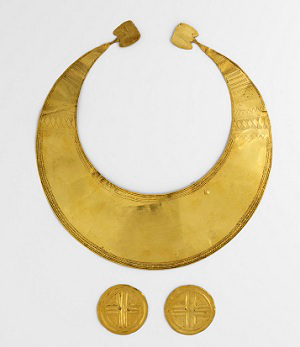

In April 2009 gardaí in Roscommon announced that they had recovered, from a rubbish skip in Dublin, some rather unusual objects: wrapped in a sheet of paper, and weighing just under 80g between them, they had been in a safe stolen from a pharmacy in Strokestown.
Following the robbery, the owners told investigating gardaí that the safe had contained three pieces of gold jewellery. From the description provided, curators from the National Museum believed the jewellery to be gold ornaments of the Early Bronze Age period. Due to the thin and flat nature of the objects and their extremely light weight (78g in total, about 2½ ozs), it became apparent that the thieves might have entirely missed them. What the gardaí recovered from the smelly skip were an Early Bronze Age lunula—a crescent-shaped collar—and two gold discs of the kind found at Tedavnet. The lunula (the word was first applied in the eighteenth century and is Latin for ‘little moon’) was made by beating gold into a very thin sheet on which decorations were incised or impressed with considerable skill. Like other lunulae, the Coggalbeg example is a very clever object: producing a highly impressive and seemingly large token of high status from a relatively small amount of gold.
The ornaments, which had been dug up from a bog at Coggalbeg, Co. Roscommon, in 1945, make up a unique assemblage of objects. They represent ‘the first time ever that we have an association between the discs and the lunula, because the discs would be considered amongst the earliest gold ornaments and the lunula as coming a little bit later’, says Mary Cahill of the National Museum. The appearance of discs and a lunula together opens up the possibility that they may have functioned as part of the same set of regalia, with the discs representing the sun and the lunula the moon. More than 80 of the 100-plus gold lunulae found in western Europe come from Ireland; thus offering the first strong evidence we have of a distinctively Irish cultural form in gold. Instead of Ireland adopting influences from abroad, the process in this case seems to work the other way: Irish gold lunulae spread to Britain, and their shape is copied in necklaces of other materials, such as jet and amber.